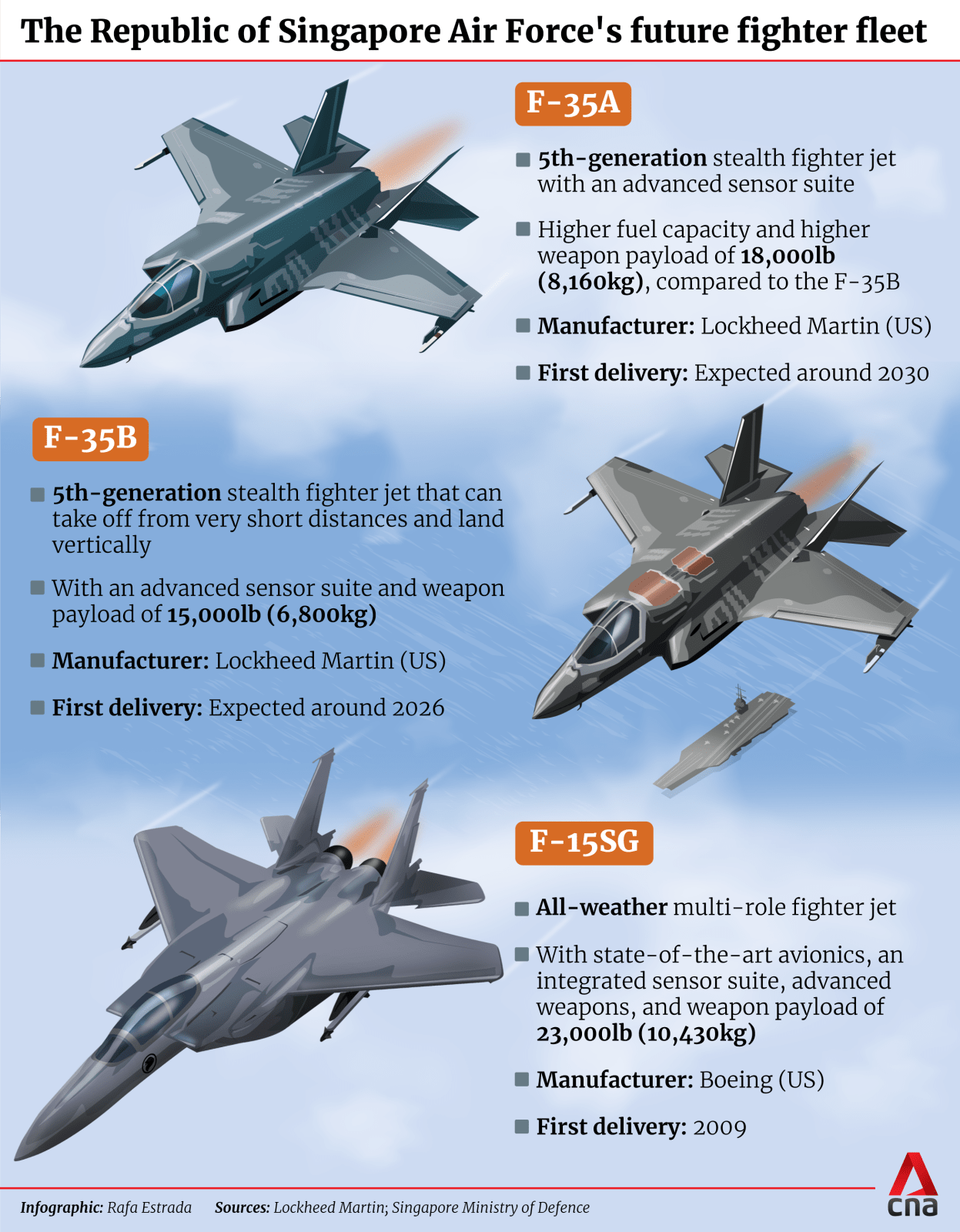SINGAPORE: The Republic of Singapore Air Force (RSAF) will buy eight F-35A jets, continuing its build-up of a “next-generation” force to serve the country’s security needs.
The aircraft are expected to be delivered around 2030, Defence Minister Ng Eng Hen said during the Ministry of Defence’s (MINDEF) budget debate in parliament on Wednesday (Feb 28).
This is on top of RSAF’s existing order of 12 F-35 jets of the “B” variant, expanding its full fleet of the fifth-generation US-made fighter aircraft to 20.
Once operational, the F-35 jets will put Singapore’s air force in the “premier league”, he said.
The purchase is timed to capitalise on a “window of opportunity”. F-35 prices are now more competitive amid a healthy order pipeline for the jets globally, said Dr Ng, who did not reveal the cost of Singapore’s F-35A purchase.

Overall, MINDEF’s expenditure will hit S$20.2 billion (US$15 billion) in the 2024/2025 financial year, up 2.5 per cent from the previous year, he told parliament.
But Dr Ng pointed out that despite nominal increases in defence spending, its share as a percentage of gross domestic product has fallen because it has been outpaced by economic growth.
Around 20 years ago, Singapore was spending about 5 per cent of GDP on defence.
In the current and upcoming financial year, the defence budget has held steady at 3 per cent, even though total government spending as a percentage of GDP has risen.
MINDEF expects its spending to stay “in this range” over the next decade, barring conflicts and wars, said Dr Ng.
He added that the fall as a percentage of GDP was not because SAF cut back on what was necessary to defend Singapore, but because of sustained spending to build a strong military over the long term.
“So today, we are reaping dividends of the sums we put in steadily over the past 20 years. And if we continue to invest wisely, we will reap more dividends in the future,” he said.
Dr Ng opened his speech by referring to the ongoing Russia-Ukraine and Israel-Hamas wars. He also sketched the consequences of the trade war between the United States and China, which could grow to more areas in the name of national security.
“I can assure this House that surprises and unintended consequences are in store, some linked, others completely out of the blue. When the ambient temperature of geopolitics rises, sparks and fires will arise from multiple sources,” he said.
“So, I have reversed my assessment for today’s generation in Singapore and elsewhere. The risk of regional and even global conflict in the next decade has become non-zero. I do not make this assessment lightly.”
He stressed the importance of a strong SAF to deter aggression and adventurism.
FUTURE FIGHTER FLEET
RSAF acquired its first four F-35B jets in 2020, and these are on track to be delivered in 2026. The eight F-35B jets acquired in 2023 are projected for delivery in 2028, according to Dr Ng.
MINDEF may have to deprioritise other projects to enable the F-35A purchase. “But we’ve done our calculations, and we think that this is the best time to put the order for the F-35As,” he said.
The Singapore government does not give detailed cost figures for the acquisition of planes, submarines and army platforms as these can provide an indication of capabilities.
But the price reportedly averaged around US$82.5 million for F-35A jets to be delivered from 2023 to 2025, according to a US government spokesperson.
F-35 costs vary according to the exact package that is negotiated, and this differs from country to country, Lieutenant-Colonel Zhang Jianwei, head of the Next Generation Fighter Project Office in RSAF’s Air Plans Department, said at a media preview on Monday.
The “B” variant of the F-35 is specially designed to take off at short distances and land vertically. It enhances Singapore’s resilience against attacks on the country’s runways, said LTC Zhang.
In contrast, the “A” variant of the F-35 takes off and lands conventionally, but can carry more fuel for greater endurance, as well as heavier weapon payloads.
The F-35 jets will replace Singapore’s ageing fleet of F-16s, which are slated for retirement from the mid-2030s.
The RSAF’s future fleet of fighters will comprise the F-35A, F-35B and F-15SG jets. Together, they can perform the “full suite of missions required to defend Singapore skies”, said LTC Zhang.
The F-15SG jets, which became fully operational in 2013, will do the “heavy lifting” as they can carry even greater payloads, he said.
Asked whether RSAF foresees acquiring other types of aircraft, LTC Zhang said the plan is to operate a diversified fleet of the F-35A, F-35B and F-15SG.
“But we constantly review our needs against what is available on the market,” he added.
Singapore is one of four countries in the Indo-Pacific to acquire F-35s, along with Australia, Japan and South Korea. Globally, F-35 users include Canada, Israel, the United Kingdom and other European powers.
On other military hardware, Dr Ng said the navy will launch its fourth and final submarine in Kiel, Germany later this year. All four submarines will be operational around Singapore waters by 2028.
He also gave more details on SAF’s use of autonomous vehicles. The navy’s unmanned surface vessels turn fully operational this year and will patrol the Singapore Strait alongside existing vessels.
Navy ships will have close-range unmanned aerial vehicles, or drones, by the second half of 2024 to extend their surveillance range.
Drone usage will also filter down to army soldiers, supporting soldiers on foot for last-mile surveillance.
[Next we will need to get MALDs (Miniature Air Launched Decoys) as well as unmanned Loyal Wingman drones. The F35s are "quarterbacks", and they need "runners", and "scorers" - either F15EX (missile trucks), or Loyal Wingman Collaborative Combat Aircraft (CCA, Drones), or MALDs (miniature decoys) to provide extra protection for the "Quarterbacks". In a pinch, the F15SG can be both missile trucks, and "decoys" or distractions.
No comments:
Post a Comment